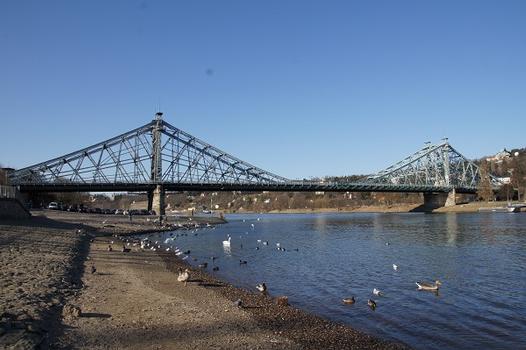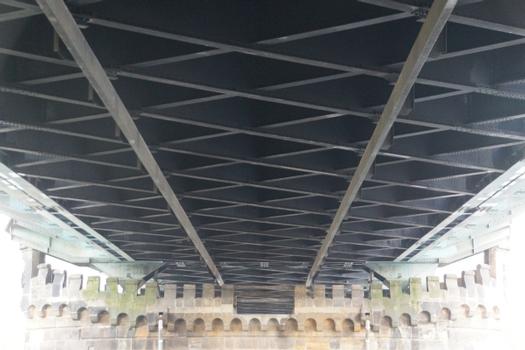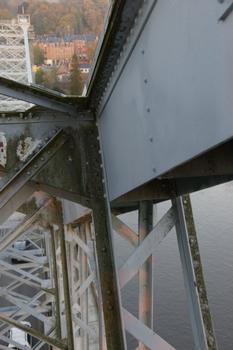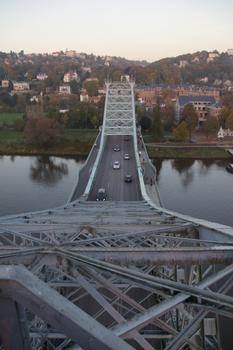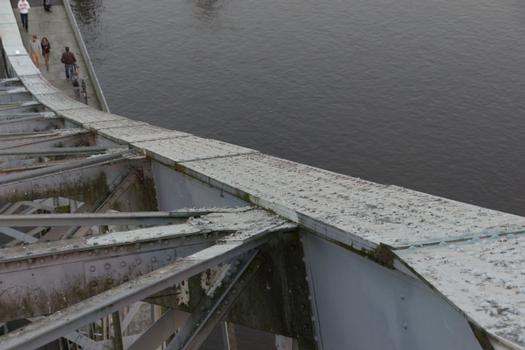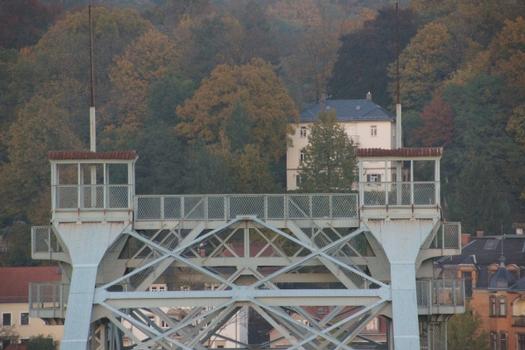General Information
| Name in local language: | Blaues Wunderr; Loschwitzer Brücke; König-Albert-Brücke; Loschwitz-Blasewitzer-Brücke |
|---|---|
| Beginning of works: | 1 April 1891 |
| Completion: | 15 July 1893 |
| Status: | in use |
Project Type
| Structure: |
Cantilever truss bridge |
|---|---|
| Function / usage: |
Road bridge |
| Material: |
Iron bridge Structurae Plus/Pro - Subscribe Now! |
Location
| Location: |
Dresden, Saxony, Germany |
|---|---|
| Crosses: |
|
| Coordinates: | 51° 3' 12.33" N 13° 48' 36.74" E |
Technical Information
Dimensions
| total length | 270.2 m | |
| span lengths | 61.76 m -146.68 m - 61.76 m | |
| number of spans | 3 |
Quantities
| structural steel | 3 200 t |
Materials
| superstructure |
wrought iron
|
|---|---|
| piers |
masonry
|
Chronology
| 1 April 1891 | Construction begins |
|---|---|
| 11 July 1893 | Load tests. |
| 1923 | Toll is abolished |
Excerpt from Wikipedia
Loschwitz Bridge (Loschwitzer Brücke) is a cantilever truss bridge over the river Elbe in Dresden the capital of Saxony in Germany. It connects the city districts of Blasewitz and Loschwitz, two affluent residential areas, which around 1900 were amongst the most expensive in Europe. It is located close to Standseilbahn Dresden funicular railway and the world's oldest suspension railway Schwebebahn Dresden, as well as near the Dresden TV tower. The bridge is colloquially referred to as Blaues Wunder ("Blue Wonder"). This common name purportedly referred to the bridge's original blue colour and being seen as a technological miracle at the time; it is also understood to carry the cynical connotation referencing the German idiom ein blaues Wunder erleben meaning "to experience an unpleasant surprise" (literally: "to experience a blue wonder"), reflecting the skeptical view of contemporary commentators. There is also a bridge in Wolgast known as Blaues Wunder.
After a two-year construction time, the bridge was completed in 1893 at a cost of 2.25 million Goldmarks (equivalent to 13 million 2009 €) and named König-Albert-Brücke in honor of King Albert of Saxony. In the 19th century, a bridge of this length without supporting river piers was considered a technological masterpiece. Today the technology is less miraculous, but the bridge is a much-loved symbol of the city.
The original bridge toll was renounced during the 1923 hyperinflation. Near the end of World War II, the bridge was saved from being destroyed by an SS unit when two people cut the detonator wires to explosives. Preserved in ist original construction, the advanced age of the structure in recent years has led to some traffic limiting. It was until the opening of the Waldschlösschenbrücke on 26 August 2013 the only Elbe crossing in Dresden East of the city centre.
The surrounding area of 19.3 km² (7.5 sq mi) of the Elbe meadows was declared a cultural World Heritage Site by the UNESCO in 2004, but lost the title in 2009 following the construction of the Waldschlösschenbrücke, meant to relieve congestion on the Blue Wonder.
Text imported from Wikipedia article "Loschwitz Bridge" and modified on 03 June 2020 according to the CC-BY-SA 3.0 license.
Participants
- Claus Köpcke (designer)
Relevant Web Sites
Relevant Publications
- (2008): Das Blaue Wunder. Oder: Gedanken über die Schönheit. In: (2008): Dresdner Elbbrücken in acht Jahrhunderten. Dresdner Geschichtsverein e.V., Dresden (Germany), ISBN 978-3-910055-90-2, pp. 61-69.
- (2006): Das Blaue Wunder - Entwicklung neuer Methoden in der Tragwerksbeurteilung. In: Stahlbau, v. 75, n. 10 (October 2006), pp. 828-833.
- (1992): Das blaue Wunder über die Elbe in Dresden 100 Jahre alt. In: Beton- und Stahlbetonbau, v. 87, n. 9 (September 1992), pp. 235-237.
- (2002): Bridges that Changed the World. Prestel, Munich (Germany), pp. 80-81.
- (1997): Brücken am Weg. Frühe Brücken aus Eisen und Beton in Deutschland und Frankreich. Wilhelm Ernst & Sohn Verlag für Architektur und technische Wissenschaften GmbH, Berlin (Germany), ISBN 978-3-433-01299-4, pp. 97-101.
- About this
data sheet - Structure-ID
20000500 - Published on:
14/11/1999 - Last updated on:
18/01/2020

